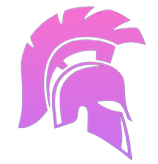
- World of Warcraft
-
Dragonflight 10.2Dragonflight 10.2
-
GoldGold
-
Mythic+ DungeonsMythic+ Dungeons
-
RaidsRaids
-
AmirdrassilAmirdrassil
-
Character BoostCharacter Boost
-
GearingGearing
-
ProfessionsProfessions
-
ReputationsReputations
-
- Call of Duty
-
Modern Warfare 3Modern Warfare 3
-
MW3 Camo BoostingMW3 Camo Boosting
-
MW3 Weapon LevelingMW3 Weapon Leveling
-
Modern Warfare 2Modern Warfare 2
-
MW2 Camo BoostingMW2 Camo Boosting
-
Warzone 2Warzone 2
-
WZ Rank BoostWZ Rank Boost
-
WZ Wins BoostWZ Wins Boost
-
Modern Warfare ZombiesModern Warfare Zombies
-
- Apex Legends
-
Rank BoostingRank Boosting
-
Predator BoostPredator Boost
-
Kills FarmKills Farm
-
Badge BoostBadge Boost
-
Damage BadgesDamage Badges
-
20 kills20 kills
-
4000 damage4000 damage
-
20 kills + 4k damage20 kills + 4k damage
-
- The Finals
-
Leagues BoostLeagues Boost
-
Ranked UnlockRanked Unlock
-
VRs FarmVRs Farm
-
Battle Pass BoostBattle Pass Boost
-
Triangle Twinkle BoostTriangle Twinkle Boost
-
- Diablo 4
- Counter Strike 2
- Overwatch 2
- Valorant
- World of Warcraft
-
Dragonflight 10.2Dragonflight 10.2
-
GoldGold
-
Mythic+ DungeonsMythic+ Dungeons
-
RaidsRaids
-
AmirdrassilAmirdrassil
-
Character BoostCharacter Boost
-
GearingGearing
-
ProfessionsProfessions
-
ReputationsReputations
-
- Call of Duty
-
Modern Warfare 3Modern Warfare 3
-
MW3 Camo BoostingMW3 Camo Boosting
-
MW3 Weapon LevelingMW3 Weapon Leveling
-
Modern Warfare 2Modern Warfare 2
-
MW2 Camo BoostingMW2 Camo Boosting
-
Warzone 2Warzone 2
-
WZ Rank BoostWZ Rank Boost
-
WZ Wins BoostWZ Wins Boost
-
Modern Warfare ZombiesModern Warfare Zombies
-
- Apex Legends
-
Rank BoostingRank Boosting
-
Predator BoostPredator Boost
-
Kills FarmKills Farm
-
Badge BoostBadge Boost
-
Damage BadgesDamage Badges
-
20 kills20 kills
-
4000 damage4000 damage
-
20 kills + 4k damage20 kills + 4k damage
-
- The Finals
-
Leagues BoostLeagues Boost
-
Ranked UnlockRanked Unlock
-
VRs FarmVRs Farm
-
Battle Pass BoostBattle Pass Boost
-
Triangle Twinkle BoostTriangle Twinkle Boost
-
- Diablo 4
- Counter Strike 2
- Overwatch 2
- Valorant
- World of Warcraft
-
Dragonflight 10.2Dragonflight 10.2
-
GoldGold
-
Mythic+ DungeonsMythic+ Dungeons
-
RaidsRaids
-
AmirdrassilAmirdrassil
-
Character BoostCharacter Boost
-
GearingGearing
-
ProfessionsProfessions
-
ReputationsReputations
-
- Call of Duty
-
Modern Warfare 3Modern Warfare 3
-
MW3 Camo BoostingMW3 Camo Boosting
-
MW3 Weapon LevelingMW3 Weapon Leveling
-
Modern Warfare 2Modern Warfare 2
-
MW2 Camo BoostingMW2 Camo Boosting
-
Warzone 2Warzone 2
-
WZ Rank BoostWZ Rank Boost
-
WZ Wins BoostWZ Wins Boost
-
Modern Warfare ZombiesModern Warfare Zombies
-
- Apex Legends
-
Rank BoostingRank Boosting
-
Predator BoostPredator Boost
-
Kills FarmKills Farm
-
Badge BoostBadge Boost
-
Damage BadgesDamage Badges
-
20 kills20 kills
-
4000 damage4000 damage
-
20 kills + 4k damage20 kills + 4k damage
-
- The Finals
-
Leagues BoostLeagues Boost
-
Ranked UnlockRanked Unlock
-
VRs FarmVRs Farm
-
Battle Pass BoostBattle Pass Boost
-
Triangle Twinkle BoostTriangle Twinkle Boost
-
- Diablo 4
- Counter Strike 2
- Overwatch 2
- Valorant
- World of Warcraft
-
Dragonflight 10.2Dragonflight 10.2
-
GoldGold
-
Mythic+ DungeonsMythic+ Dungeons
-
RaidsRaids
-
AmirdrassilAmirdrassil
-
Character BoostCharacter Boost
-
GearingGearing
-
ProfessionsProfessions
-
ReputationsReputations
-
- Call of Duty
-
Modern Warfare 3Modern Warfare 3
-
MW3 Camo BoostingMW3 Camo Boosting
-
MW3 Weapon LevelingMW3 Weapon Leveling
-
Modern Warfare 2Modern Warfare 2
-
MW2 Camo BoostingMW2 Camo Boosting
-
Warzone 2Warzone 2
-
WZ Rank BoostWZ Rank Boost
-
WZ Wins BoostWZ Wins Boost
-
Modern Warfare ZombiesModern Warfare Zombies
-
- Apex Legends
-
Rank BoostingRank Boosting
-
Predator BoostPredator Boost
-
Kills FarmKills Farm
-
Badge BoostBadge Boost
-
Damage BadgesDamage Badges
-
20 kills20 kills
-
4000 damage4000 damage
-
20 kills + 4k damage20 kills + 4k damage
-
- The Finals
-
Leagues BoostLeagues Boost
-
Ranked UnlockRanked Unlock
-
VRs FarmVRs Farm
-
Battle Pass BoostBattle Pass Boost
-
Triangle Twinkle BoostTriangle Twinkle Boost
-
- Diablo 4
- Counter Strike 2
- Overwatch 2
- Valorant

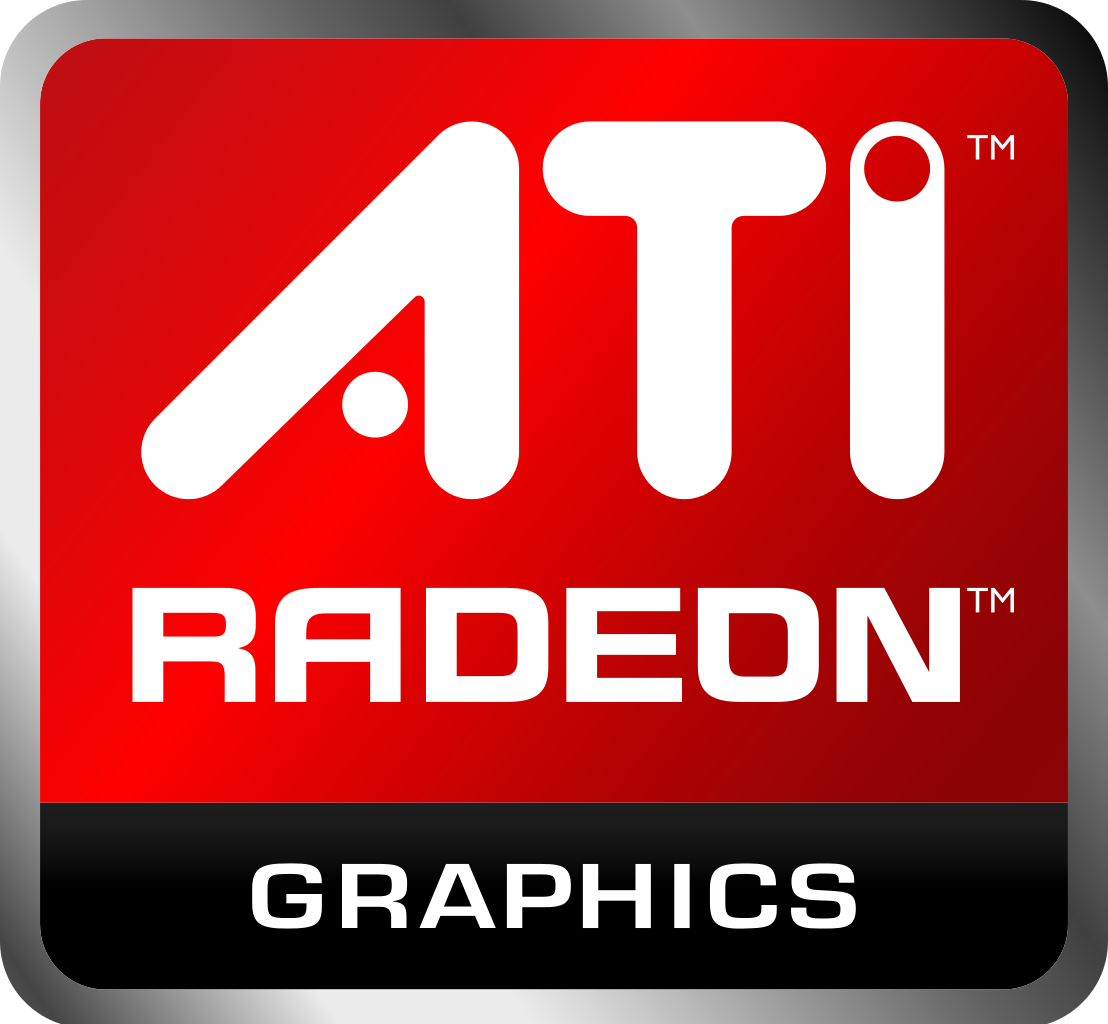
Competition in Graphics Chip making industry has grown since the fall of “Titan” or fall of 3DFX Company in 2000. Some say this was due to nVidia due to the fact that it was the only rival of 3DFX. But it was not nVidia but it was the mismanagement of assets and other internal problems of 3DFX that accounts for its fall.
After the fall of 3DFX, this left an opening for ATI to pick up more and more 3D Graphics share in the market. While it’s true that ATI has recently made a big push in the market but many are unaware of the ATI’s true history of being one of the first and the most popular OEM Graphics Manufacturer of the industry.
Kwok Yuen Ho
ATI’s history begins with Kwok Yuen Ho. ATI’s Founder and CEO. Born in 1950 to a once-wealthy family displaced by Communist in China. He lived a life of poverty. As a youngest in his family, he found himself picking vegetables in his family Garden. His father, once a teacher, had to move to Hong Kong as a laborer in an industry so he could send as mush money to his family as he can. In 1962, they moved ton one room apartment in Honk Kong. His life changed, when he got a top spot at Taiwanese college, National Cheng Kung University, He Graduated in 1974 with a bachelor’s degree in Electrical Engineering. Ho worked at Philips Electronics, Control Data, National Semiconductor and Wong’s Electronics. He immigrated to Canada in 1984, where he couldn’t find a job which was as big as he could get back in his home land. He wasn’t the only one there in 1985.
ATI’s Birth:
Ho with two other Hong Kong emigrants, Benny Lau (VP of product development, retired) and Lee Lau (VP of Strategic Planning), started their own company: Array Technology Industry. With an initial investment of $300,000, which was the life savings of these three men, they decided to make ATI as Graphics Company. With a staff of 6, with the secretary, receptionist and shipping department being the same person. As a small unproven Canadian Company, many were reluctant to make deals with ATI. And in four months their money ran out. Overseas Union bank of Singapore came to rescue with another $300,000 loan which became $1.5 Million later. ATI was on it’s way.
The company’s First sale came when Commodore signed on, with 7,000 chips per week, Company’s year end revenue totaled $10 Million.
Early Products:
Mach64:
ATI introduced Mach64 in 1994. Mach 64 powered the Graphics Xpression and Graphics Pro Turbo. The first Mach64 had the hardware support required to convert YUV into RGB. A significant Milestone required to introduce MPEG Video Acceleration in PC which we see today.
Mach64-VT:
The following year ATI introduces Mach64-VT. Mach64 allowed video playback to high speed. While the VT added the filtering in X and Y axes so as to enable the Videos of 320×240 can be turned into 1024×768 without blocky Pixels. 3D Rage I and 3D Rage II was also based on this Mach 64- VT chip. In February 1997, ATI unveiled 3D Rage II+DVD, this chip helped took off load off of the CPU while DVD Playback. They also made 3D Rage Pro Which was built for AGP, the added bandwidth by AGP and MPEG-2 Support this Card was a must for every computer user. This Chip made the ATI’s Revenue jump to double then before and ATI became the true Graphics Chip Maker ever.
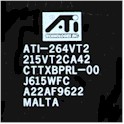
DVD Setbacks:
In late 1998, when S3 launched Savage 3D, Which offered not only top notch image quality, but also introduced a better and faster motion compensation engine, up-and-down-scaler as well as hardware alpha-blended sub-picture blending, which was first ever in this industry. Alpha-blended Sub Picture is used for transparency effects in menus, mostly navigation menus.
ATI’s Answer:
ATI’s counter for S3’s Savage 3D was Rage128 GL, while S3 was still better at image quality. ATI’s sub-picture blending matched S3’s, but the added iDCT support (inverse discrete cosine transfer) in the hardware this offloaded more computations from the CPU. This architecture remained an ATI’s Flagship product for almost 2 years.
Radeon:
In spring 2000 ATI launched it s current Flagship product, Radeon. This Chip added more performance and most of all this chip added support to HDTV-compatible MPEG-2 motion compensation and adaptive de-interlacing, while it’s adaptive de-interlacing added Solid 30 FPS DVD videos with high quality.
TV Products:
ATI launched TV Tuner cards (for ISA Port) the same year when they launched MACH64. Their products were Video-IT! And Video BASIC in 1994 for Windows 3.1x, Users could capture LDs (laserdisc), Video Tape (VHS) and camcorder.ATI also launched 3D Xpression PC2TV for around 300$, a 4 MB Hardware Graphics Accelerator card with TV Output in 1996. That same year, ATI also brought it’s ALL IN WONDER product out. They were just like having a Hardware acceleration card and an ISA ATI-TV in it. The other All in wonder released in 1997, was the next step with high quality TV output. And next generation of ImpactTV2 chip and so many features, these products ruled the market.
Rage Theatre:
Rage theatre or Rage all in wonder 128 32 MB, was not just a memory upgrade, but was also equipped with the latest Rage companion chip. This chip was different from the other chip. Instead of using two separate chips for TV Out put and TV input, these chips could handle both of the process with Performance never before seen. With more flicker free filters and higher bit rate then the previous AIW Products, this product was a must buy. Unfortunately in 1999 November the launch of Voodoo3 3500TV, Rage Theatre din t do much in the market because of the fact that it’s 3-D Handling was nowhere comparable to Voodoo3, Laggy Performance in 3-D Data handling was the prime issue in it’s failure.
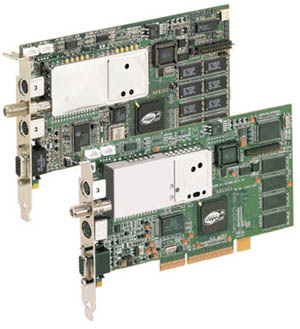
Radeon AIW:
Radeon AIW equipped with 32 MB ram, Was one of its kind, with a unique feature called Time shifting, in this feature when your watching a TV show and you want to go a little back for some spectacular scene, you could do that, while you wouldn’t miss your shows since it’s being recorded on that hard disk. This was only possible due to the fact that CPUs in 2000 Era were much faster then their predecessors.
3D Graphics Accelerator:
First 3-D Graphic Chip:
ATI’s First top to end 3-D product was 3D Rage II. It had the hardware Z-buffer unlike the first one. The Chip offered compressed texture, Bilinear Filtering, Trilinear Filtering and many Direct3D Blend Modes of that time. As a Mainstream Product RAGE II had to compare against S3 Virge and Matrox Mystique, Some of which did not even offered Trilinear Filtering. Over all ATI was gaining the market share with this chip. The consumers were looking for DVD Options available with ATI’s Cards.
Overall the few versions of the ATI’s Graphics card were best of the best. At times the only thing left was the drivers. If ATI had concentrated more on their Drivers then their Original Chips, It would’ve made millions. Let us study the following scenario:
The Card was:
The 3D Rage Pro:
The 3D Rage Pro was one of the best cards of it’s time with one of the impressive spec sheet. The Rage Pro offered a fill rate of 45Mpixels/second, VQ texture compression, and a 1.2 M triangles/sec full triangle setup engine. The chip had single-pass trilinear filtering as well as a complete set of texture blending options. But the Drivers were limited. Due to the fact that ATI din t improved their Drivers version. The card had to suffer a lot. For the Fact that when ATI’s 3D Rage Pro was in full swing (After some Driver Changes and releases), there were other cards in market that offered much more power then ATI’s like 3dfx’s Voodoo2 and Nvidia’s RIVA128 with 100 Mpixels/sec Fill rate and 5M Polygons/sec. Nvidia’s Riva128 was even enough to put ATI way behind the line. If ATI had release these Graphics (tweaked) earlier when they launched the card, they would have made a fortune out of it. They (drivers) were named Turbo Drivers and for that purpose they even named the 3D Rage pro to 3D Rage Pro Turbo, With the final driver set arriving in 1999 when 3D Gaming Graphics market had 20%-40% increase in performance of chips, ATI was forgotten.
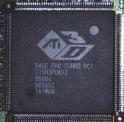
RAGE 128 GL:
When nVIDIA was winning over the OEMs, ATI knew it had to do something and some thing quick. In late 1997, ATI acquired the assets of Tseng Labs, The Producer of ET6000 which many of you remember as the pure rival of 3dfx Voodoo Graphics. 40 new Engineers from Tseng Labs and ATI’s Engineers Proved to be the win win situation for ATI. They knew they had the ideas; all they needed was to work it out. They jointly completed RAGE128 GL, which was announced in late 1998. This Card had all the power to go head to head against 3dfx voodoo graphics and nVidia’s RIVA TNT.
The “GL” was derived from OpenGL, Which was only available to hardware that time. Quake 3 was based on OpenGL. One thing was disappointing, Rage128 did very well on 32Bit Graphics Computation, but was fairly left behind in 16 Bit Computations. Most of the Games of that time were built on 16 Bit Computations; the card had to face tough time holding out in the market.
It would’ve been a successful product if it wasn t for Apple acquiring most of the initial line. It bearly got out before TNT2 and TNT2 Ultra which had a significant performance boost. But nonetheless it was a balance card with low price tag, balanced Graphics and most of all top notch DVD support.
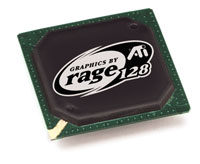
RAGE 128 Pro:
Just like nVidia, ATI released their Pro version of the Rage 128 GL, with added features like: Anisotropic Filtering, a better triangle setup engine and Higher Clock rate. In fact it was the official chip of the Quakecon 99. Although it wasn’t the mainstream product, the mainstream product was ATI Rage Fury Pro, with Theatre input and theatre output.
Project Aurora:
While ATI was showing off its Rage chip, Engineers at ATI were working on a brilliant idea which turned out to be named MAXX, which had two Rage Pro chips in parallel, this meant they both had their own memory, which added to the cost. ATI name this Board as the Gamer Choice. It couldn t do well at lower Resolutions. But at resolutions like 1600×1200, it would do some good. It s strength was also seen on high end CPUs (of that time). While, at Nvidia’s there Geforce256 SDR couldn’t do as well as ATI’s MAXX did, but nonetheless neither of the cards provided the reasonable frame rates at those resolutions.
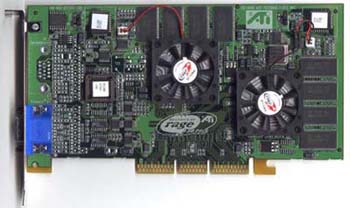
GDC 2000: History in the making:
At Game Developer’s Conference ATI shocked everyone with their new “Charisma Engine” and “Pixel Tapestry”. No name was assigned to that chip at that moment..
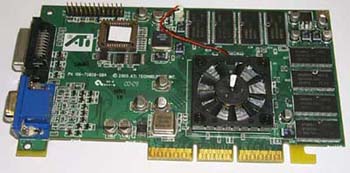
One Month Later, ATI’s this Chip was named Radeon 256.
The Dream comes true:
In 2000, ATI came with new and improved Radeon Family, Dumping the Rage architecture must have been the toughest decision, but the only way to stay in the market, ATI had to build an Architecture that could lead them to the top of the ladder and Radeon was certainly the name in their head. 2000 also brought the fall of 3dfx which was consumed/dissolved by nVidia. So ATI had the opportunity to avail and they did with their Radeon Family. But sad, The ATI’s driver couldn’t meet up with enhancement in the hardware. It’s like that you made a plan to build a bridge and all you lacked is a design for support.
Radeon 8500:
In 2001, ATI unveiled ATI Radeon 8500. next generation of Graphics Processing Power. Still the same problem persists. The Drivers and ATI’s Poor software support nearly crippled all other products in its history, Its like putting an F-16 JET Engine in an airliner. They supplied the architecture but not the stuff to run it at optimal speeds. It had the potential to even crush the Geforce. But the year 2001 brought a promise, a promise of 3D Gaming culture.
Radeon 9700:
While Nvidia was showing off its TI Series, ATI came back with its 9700 Line. It’s very own Direct X 9 compatible cards. They were the first true jewels. With the introduction of Catalyst Drivers, These cards did perform better, and took nVidia totally off guard. Gamers rushed to get these Cards. ATI like always released these cards in flavors like PRO and etc. This Card proved to be the best thing for ATI ever because of the fact that driver support for the card wasn’t that bad. ALL-IN-WONDER series of these cards sold like hot cakes. Other Variants of 9700 includes: 9500, 9550 and 9600.
Radeon 9800:
9800 was also a success for ATI. Every gamer on the street was dreaming to get these line of cards. 9800 Cards are actually an upgraded version of 9700 cards. 9800 XT, being the crown jewel of these 9800 cards, was the most expensive in the series when they were launched. With a clock speeds higher then that of all other in these series. And with a special contract with VALVE to include/bundle Halflife 2 with most of ATI’s Card like 9600, 9700 and 9800 XT, made these cards a must buy in every gamer’s Christmas list. These cards were actually a counter against the FX Series of nVidia’s Cards like 5900 & 5900 Ultra
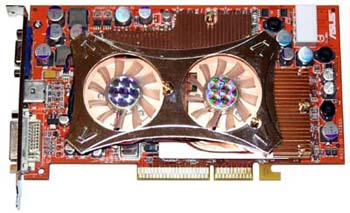
Radeon X800 Series:
Currently the most wanted card by the loyal ATI gamers. This Card broke all records. With maximum of 16 Pipeline, 160 Million transistors, 256 bit mode and great performance with Halflife 2, this card is a must for Halflife 2 Fans. While the new in these series X850 Series are the real crowns.
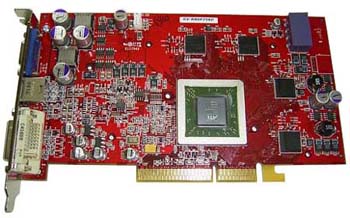
Conclusion:
Over all ATI is a company that can sure give nVidia a tough time. You can see that ATI is a company that prefers to work slowly and gradually and come back hard with products like radeon. It’s like a wine, more old = delicious as hell. Considering experience ATI had gain with all these years being in the industry I think, they’ll always come up with brilliant solutions like all in wonder.